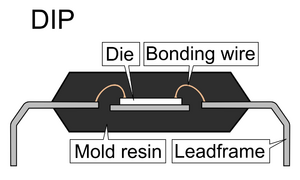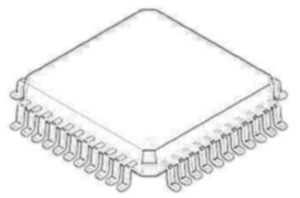Integrated circuit facts for kids
An integrated circuit (often called an IC, microchip, or just chip) is a tiny electronic circuit. It's made on a small piece of special material, usually silicon, called a semiconductor. Think of it as a super tiny city of electronic parts, all connected together.
These chips are amazing because they can hold many parts like transistors, resistors, and capacitors. They are made using special photographic methods. Because they are so small and delicate, they are usually protected inside a tough plastic case. Tiny metal legs stick out of the case to connect the chip to other electronics.
Integrated circuits have two big benefits: they are cheap to make and they work very fast. Millions of tiny parts can be printed all at once, which saves a lot of money. They also use very little power and can switch on and off incredibly quickly. This makes them perfect for almost all modern electronic devices.
Contents
What is a Semiconductor?
A semiconductor is a material that can be controlled to either conduct electricity well or not at all. This special ability allows engineers to create tiny switches called transistors. These transistors can then control each other, forming complex circuits.
Silicon is the most common semiconductor used in chips. You can find semiconductors in many everyday items. These include radios, computers, telephones, and even solar cells and LED lights.
Who Invented the Integrated Circuit?
The idea for the integrated circuit came to two different people around the same time. This happened in 1958 and 1959. Back then, transistors were common in electronics. They were much smaller than old vacuum tubes. But for new devices like missile guidance systems, even transistors weren't small enough.
Jack Kilby's "Solid Circuit"
In July 1958, Jack Kilby was working at Texas Instruments. He had a brilliant idea: what if all parts of a circuit could be made from the same material, like silicon? At that time, parts like capacitors and resistors were not made from semiconductors. Kilby's boss liked the idea and told him to build it.
By September 12, Kilby had a working model. He called it a "Solid Circuit." It was about the size of a fingertip. Texas Instruments quickly filed a patent for his invention.
Robert Noyce's "Unitary Circuit"
Meanwhile, in January 1959, Robert Noyce was working at a small company called Fairchild Semiconductor. He also realized that an entire circuit could fit onto a single chip. While Kilby focused on making individual parts from silicon, Noyce thought of a better way to connect all these parts together on the chip.
Noyce's design was called a "unitary circuit." His detailed plan paid off. On April 25, 1961, Robert Noyce was awarded the first patent for an integrated circuit. Kilby's patent application was still being reviewed. Today, both men are recognized for coming up with this amazing idea independently.
How Integrated Circuits Grew: Generations of Chips
Over the years, integrated circuits have become much more powerful. We can put more and more transistors on a single chip. This led to different "generations" of ICs:
| Name | Time Period | Number of Transistors (about) |
|---|---|---|
| SSI (Small-Scale Integration) | Early 1960s | A few transistors on each chip |
| MSI (Medium-Scale Integration) | Late 1960s | Hundreds of transistors on each chip |
| LSI (Large-Scale Integration) | Mid 1970s | Tens of thousands of transistors per chip |
| VLSI (Very Large-Scale Integration) | Late 20th century | Hundreds of thousands to several billion transistors |
| ULSI (Ultra-Large Scale Integration) | 21st century | More than 1 million transistors |
How Chips Are Packaged
Integrated circuits come in many different shapes and sizes. The way a chip is protected and connected is called its "package." Some common types of packages include:
- DIP (Dual in-line package)
- PLCC (Plastic leaded chip carrier)
- TSOP (Thin small-outline package)
- PQFP (Plastic Quad Flat Pack)
Some very small chips are designed for surface-mount technology. This means they are soldered directly onto the surface of a circuit board. Most chips today use MOSFET transistors, which are very efficient.
Related pages
Images for kids
-
Erasable programmable read-only memory (EPROM) integrated circuits in dual in-line packages. These packages have a transparent window that shows the die inside. The window is used to erase the memory by exposing the chip to ultraviolet light.
-
Jack Kilby's original hybrid integrated circuit from 1958. This was the first integrated circuit, and was made from germanium.
-
Robert Noyce invented the first monolithic integrated circuit in 1959. The chip was made from silicon.
-
A-to-D converter IC in a DIP
-
The die from an Intel 8742, an 8-bit NMOS microcontroller that includes a CPU running at 12 MHz, 128 bytes of RAM, 2048 bytes of EPROM, and I/O in the same chip
-
Rendering of a small standard cell with three metal layers (dielectric has been removed). The sand-colored structures are metal interconnect, with the vertical pillars being contacts, typically plugs of tungsten. The reddish structures are polysilicon gates, and the solid at the bottom is the crystalline silicon bulk.
See also
 In Spanish: Circuito integrado para niños
In Spanish: Circuito integrado para niños











